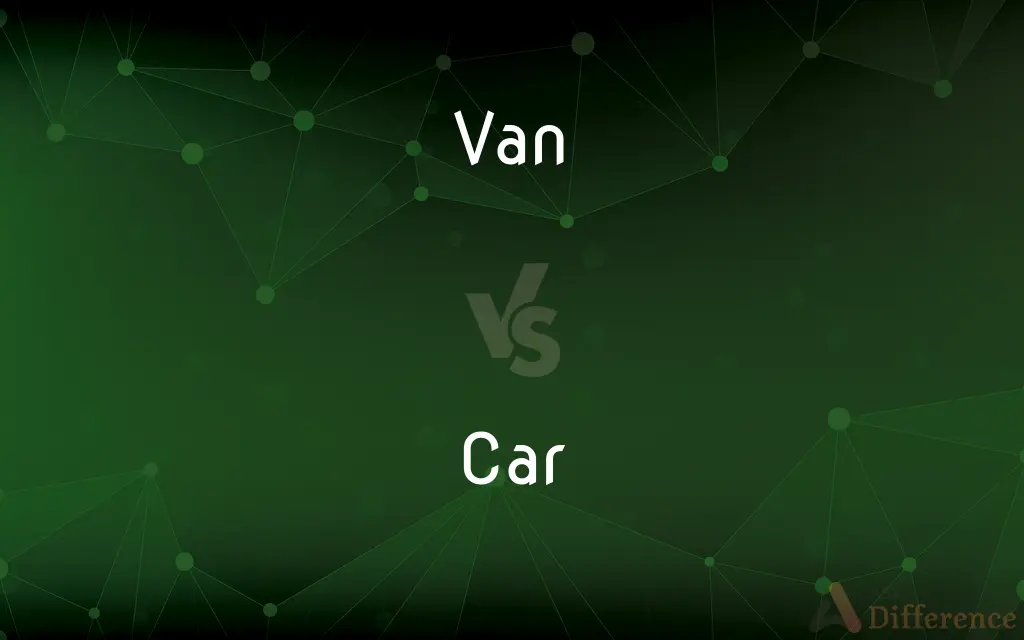Van vs. Car — What's the Difference?
Edited by Tayyaba Rehman — By Maham Liaqat — Updated on March 29, 2024
A van is designed for transporting goods or people with a boxy shape and ample space, while a car is generally smaller, designed for personal transport with more focus on performance and style.

Difference Between Van and Car
Table of Contents
ADVERTISEMENT
Key Differences
Vans are typically characterized by their large, boxy design, intended to maximize interior space for the transport of goods or passengers. Cars, on the other hand, come in a variety of shapes and sizes, from compact sedans to sporty convertibles, prioritizing aesthetics, performance, and fuel efficiency over cargo space.
The primary function of a van is to offer practicality and versatility. They often feature sliding side doors and large rear doors for easy loading and unloading. Cars, whereas, emphasize comfort, driving pleasure, and safety features tailored to personal use and family travel.
Vans are favored by businesses for deliveries and by families for their spacious interiors, capable of accommodating more passengers and cargo. Cars, on the other hand, are preferred for everyday use, offering better maneuverability and parking ease in urban environments.
In terms of fuel efficiency and environmental impact, vans, due to their larger size and heavier weight, tend to consume more fuel and emit more CO2 than most cars. Cars are designed to be more fuel-efficient, with many models offering hybrid or electric options for eco-conscious drivers.
While vans provide a straightforward, functional design focused on utility, cars offer a wider range of design aesthetics, luxury features, and technological advancements, reflecting personal taste and lifestyle choices.
ADVERTISEMENT
Comparison Chart
Primary Use
Transporting goods/people
Personal transport
Design
Boxy, maximizes interior space
Varied, often sleek and aerodynamic
Doors
Sliding side doors, large rear doors
Hinged doors, typically 2 or 4
Capacity
Higher passenger and cargo capacity
Limited by size and design
Fuel Efficiency
Generally lower due to size/weight
Generally higher, with eco-friendly options
Maneuverability
Less maneuverable, harder to park
More maneuverable, easier to park
Preferred Environment
Businesses, large families, transport
Everyday use, personal or family travel
Features
Functional, practical
Range from basic to luxury, high-tech
Compare with Definitions
Van
A van is a large vehicle used for transporting goods or people, often used by businesses and families.
The delivery company uses a fleet of vans to transport parcels.
Car
A car is a wheeled motor vehicle used for transportation, typically with four seats and designed for efficiency and ease of use.
Her compact car is perfect for city driving and parking.
Van
Minivans are a type of van designed for personal use, offering ample space and comfort for families.
Their minivan has sliding doors and a built-in DVD player for the kids.
Car
SUVs (Sport Utility Vehicles) are versatile cars designed for both city driving and off-road capability.
Their SUV is equipped with four-wheel drive for camping trips in the mountains.
Van
Cargo vans are designed specifically for transporting goods, with large, unobstructed cargo spaces.
The plumber's cargo van is equipped with shelves for tools and parts.
Car
Sedans are cars with a separate trunk, offering a balance of comfort, style, and practicality.
The family prefers a sedan for its spacious interior and smooth ride.
Van
Passenger vans are equipped with multiple rows of seats to accommodate more passengers.
The hotel shuttle is a passenger van that transports guests to the airport.
Car
Sports cars are designed for high performance and handling, often with a sleek, aerodynamic shape.
His sports car can accelerate from 0 to 60 mph in just 3.5 seconds.
Van
Full-size vans offer extensive cargo space and can be customized for specific commercial needs.
The mobile dog grooming service operates out of a customized full-size van.
Car
Electric cars run on electric power, offering an eco-friendly alternative to traditional gasoline engines.
She switched to an electric car to reduce her carbon footprint.
Van
A van is a type of road vehicle used for transporting goods or people. Depending on the type of van, it can be bigger or smaller than a truck and SUV, and bigger than a common car.
Car
A car (or automobile) is a wheeled motor vehicle used for transportation. Most definitions of cars say that they run primarily on roads, seat one to eight people, have four wheels, and mainly transport people rather than goods.Cars came into global use during the 20th century, and developed economies depend on them.
Van
An enclosed boxlike motor vehicle having rear or side doors and side panels especially for transporting people.
Car
An automobile.
Van
A covered or enclosed truck or wagon often used for transporting goods or livestock.
Car
A vehicle, such as a streetcar, that runs on rails
A railroad car.
Van
Chiefly British A closed railroad car used for carrying baggage or freight.
Car
A boxlike enclosure for people or cargo on a conveyance
An elevator car.
Van
The vanguard; the forefront.
Car
The part of a balloon or airship that carries people or cargo.
Van
A wing.
Car
(Archaic) A chariot, carriage, or cart.
Van
A winnowing device, such as a fan.
Car
A wheeled vehicle that moves independently, with at least three wheels, powered mechanically, steered by a driver and mostly for personal transportation.
She drove her car to the mall.
Van
To transport by van
Vanned the horses to the racetrack.
Car
(dated) A wheeled vehicle, drawn by a horse or other animal; a chariot.
Van
To drive or travel in a van
Vanned around the country.
Car
A four-wheeled cab, as opposed to a (two-wheeled) Hansom cab.
Van
A covered motor vehicle used to carry goods or (normally less than ten) persons, usually roughly cuboid in shape, longer and higher than a car but relatively smaller than a truck/lorry or a bus.
The van sped down the road.
Car
An unpowered unit in a railroad train.
The conductor coupled the cars to the locomotive.
Van
(British) An enclosed railway vehicle for transport of goods, such as a boxcar/box van.
Car
(rail transport) an individual vehicle, powered or unpowered, in a multiple unit.
The 11:10 to London was operated by a 4-car diesel multiple unit.
Van
(dated) A light wagon, either covered or open, used by tradesmen and others for the transportation of goods.
Car
(rail transport) A passenger-carrying unit in a subway or elevated train, whether powered or not.
From the frontmost car of the subway, he filmed the progress through the tunnel.
Van
(aerospace) A large towable vehicle equipped for the repair of structures that cannot easily be moved.
Car
A rough unit of quantity approximating the amount which would fill a railroad car.
We ordered five hundred cars of gypsum.
Van
Clipping of vanguard
Car
The moving, load-carrying component of an elevator or other cable-drawn transport mechanism.
Fix the car of the express elevator - the door is sticking.
Van
(mining) A shovel used in cleansing ore.
Car
The passenger-carrying portion of certain amusement park rides, such as Ferris wheels.
The most exciting part of riding a Ferris wheel is when your car goes over the top.
Van
A fan or other contrivance, such as a sieve, for winnowing grain.
Car
The part of an airship, such as a balloon or dirigible, which houses the passengers and control apparatus.
Van
A wing with which the air is beaten.
Car
(sailing) A sliding fitting that runs along a track.
Van
(transitive) To transport in a van or similar vehicle (especially of horses).
Car
The aggregate of desirable characteristics of a car.
Buy now! You can get more car for your money.
Van
Of law enforcement: to arrest (not necessarily in a van; derived from party van).
Car
(US) A floating perforated box for living fish.
Van
(mining) To wash or cleanse, as a small portion of ore, on a shovel.
Car
A clique or gang.
Van
The front of an army; the first line or leading column; also, the front line or foremost division of a fleet, either in sailing or in battle.
Standards and gonfalons, twixt van and rear,Stream in the air.
Car
(obsolete) A turn.
Van
A shovel used in cleansing ore.
Car
(programming) The first part of a cons in Lisp. The first element of a list.
Van
A light wagon, either covered or open, used by tradesmen and others for the transportation of goods.
Car
A small vehicle moved on wheels; usually, one having but two wheels and drawn by one horse; a cart.
Van
A large covered wagon for moving furniture, etc., also for conveying wild beasts, etc., for exhibition.
Car
A vehicle adapted to the rails of a railroad.
Van
A closed railway car for baggage. See the Note under Car, 2.
Car
A chariot of war or of triumph; a vehicle of splendor, dignity, or solemnity.
The gilded car of day.
The towering car, the sable steeds.
Van
A fan or other contrivance, as a sieve, for winnowing grain.
Car
The stars also called Charles's Wain, the Great Bear, or the Dipper.
The Pleiads, Hyads, and the Northern Car.
Van
A wing with which the air is beaten.
He wheeled in air, and stretched his vans in vain;His vans no longer could his flight sustain.
Car
The cage of a lift or elevator.
Van
To wash or cleanse, as a small portion of ore, on a shovel.
Car
The basket, box, or cage suspended from a balloon to contain passengers, ballast, etc.
Van
To fan, or to cleanse by fanning; to winnow.
Car
A floating perforated box for living fish.
Van
Any creative group active in the innovation and application of new concepts and techniques in a given field (especially in the arts)
Car
4-wheeled motor vehicle; usually propelled by an internal combustion engine;
He needs a car to get to work
Van
The leading units moving at the head of an army
Car
A wheeled vehicle adapted to the rails of railroad;
Three cars had jumped the rails
Van
A camper equipped with living quarters
Car
A conveyance for passengers or freight on a cable railway;
They took a cable car to the top of the mountain
Van
A truck with an enclosed cargo space
Car
Car suspended from an airship and carrying personnel and cargo and power plant
Car
Where passengers ride up and down;
The car was on the top floor
Common Curiosities
Can SUVs be considered cars or vans?
SUVs are considered a category of cars. They combine elements of cars and vans, offering passenger comfort with increased cargo space and off-road capability.
What is the main difference between a van and a car?
The main difference lies in their design and purpose; vans are focused on maximizing space for cargo or passengers, while cars prioritize performance, style, and fuel efficiency.
What makes sports cars different from other cars?
Sports cars are designed for high performance and handling, with powerful engines and a sleek, aerodynamic body for increased speed and agility.
Are cars more fuel-efficient than vans?
Generally, yes. Cars are typically more fuel-efficient than vans because they are lighter and smaller, and many models offer hybrid or electric options.
Can vans be used for personal transport?
Yes, vans, especially minivans, are popular among families for personal transport due to their spacious interiors and passenger capacity.
What type of van is best for transporting goods?
Cargo vans are best for transporting goods as they offer large, unobstructed cargo spaces specifically designed for this purpose.
How do minivans differ from full-size vans?
Minivans are smaller than full-size vans and are designed primarily for personal use, offering features and comforts suited for family travel, while full-size vans are geared towards commercial use with more cargo space.
Is it easier to park a car than a van?
Yes, due to their smaller size and better maneuverability, cars are generally easier to park than vans.
Are vans more expensive than cars?
The cost varies widely depending on the model and features, but vans can be more expensive than cars due to their size and the specialized features they offer for transporting goods or passengers.
Can cars be customized like vans?
Cars can be customized, but the extent and nature of customization might differ. Cars are often customized for performance, aesthetic, or comfort, while vans might be customized more for functionality.
Are electric vans available?
Yes, electric vans are available and are becoming more popular, offering an eco-friendly option for businesses and personal use without compromising on space and utility.
Can cars carry as many passengers as vans?
No, vans are specifically designed to carry more passengers, with some models capable of seating up to 15 people, which is significantly more than the average car.
Why are vans preferred for business use?
Vans are preferred for business use due to their large cargo capacity, ease of loading and unloading, and the ability to be customized for specific commercial needs.
Share Your Discovery

Previous Comparison
Claw vs. Hoof
Next Comparison
Gear vs. SprocketAuthor Spotlight
Written by
Maham LiaqatEdited by
Tayyaba RehmanTayyaba Rehman is a distinguished writer, currently serving as a primary contributor to askdifference.com. As a researcher in semantics and etymology, Tayyaba's passion for the complexity of languages and their distinctions has found a perfect home on the platform. Tayyaba delves into the intricacies of language, distinguishing between commonly confused words and phrases, thereby providing clarity for readers worldwide.














































